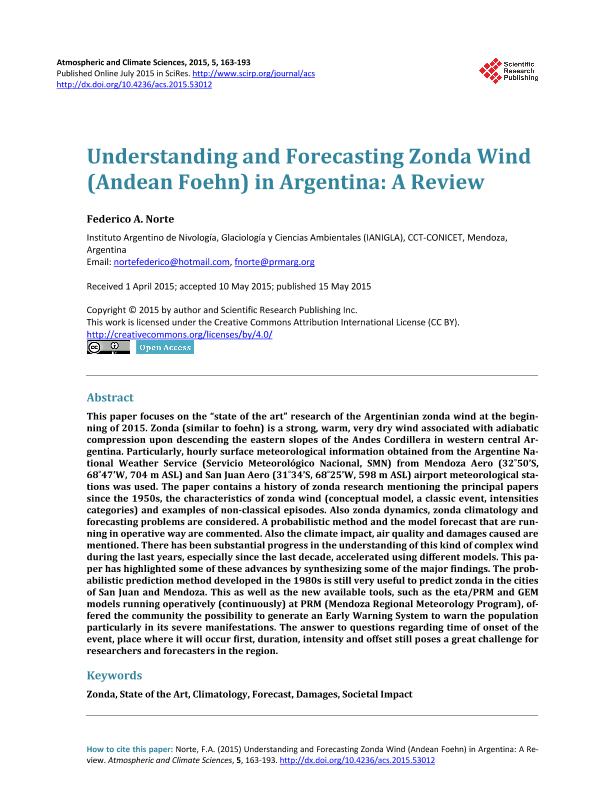Mostrar el registro sencillo del ítem
dc.contributor.author
Norte, Federico Augusto

dc.date.available
2018-09-12T20:48:47Z
dc.date.issued
2015-05
dc.identifier.citation
Norte, Federico Augusto; Understanding and Forecasting Zonda Wind (Andean Foehn) in Argentina: A Review; Scientific Research Publishing; Atmospheric and Climate Sciences; 05; 03; 5-2015; 163-193
dc.identifier.issn
2160-0422
dc.identifier.uri
http://hdl.handle.net/11336/59457
dc.description.abstract
This paper focuses on the ?state of the art? research of the Argentinian zonda wind at the beginning of 2015. Zonda (similar to foehn) is a strong, warm, very dry wind associated with adiabatic compression upon descending the eastern slopes of the Andes Cordillera in western central Argentina.Particularly, hourly surface meteorological information obtained from the Argentine National Weather Service (Servicio Meteorológico Nacional, SMN) from Mendoza Aero (32˚50?S, 68˚47?W, 704 m ASL) and San Juan Aero (31˚34?S, 68˚25?W, 598 m ASL) airport meteorological stations was used. The paper contains a history of zonda research mentioning the principal papers since the 1950s, the characteristics of zonda wind (conceptual model, a classic event, intensitiescategories) and examples of non-classical episodes. Also zonda dynamics, zonda climatology and forecasting problems are considered. A probabilistic method and the model forecast that are running in operative way are commented. Also the climate impact, air quality and damages caused arementioned. There has been substantial progress in the understanding of this kind of complex wind during the last years, especially since the last decade, accelerated using different models. This paper has highlighted some of these advances by synthesizing some of the major findings. The probabilisticprediction method developed in the 1980s is still very useful to predict zonda in the cities of San Juan and Mendoza. This as well as the new available tools, such as the eta/PRM and GEM models running operatively (continuously) at PRM (Mendoza Regional Meteorology Program), offered the community the possibility to generate an Early Warning System to warn the population particularly in its severe manifestations. The answer to questions regarding time of onset of theevent, place where it will occur first, duration, intensity and offset still poses a great challenge for researchers and forecasters in the region.
dc.format
application/pdf
dc.language.iso
eng
dc.publisher
Scientific Research Publishing
dc.rights
info:eu-repo/semantics/openAccess
dc.rights.uri
https://creativecommons.org/licenses/by-nc-sa/2.5/ar/
dc.subject
Zonda
dc.subject
Revision
dc.subject
Climatologia
dc.subject
Pronostico
dc.subject.classification
Meteorología y Ciencias Atmosféricas

dc.subject.classification
Ciencias de la Tierra y relacionadas con el Medio Ambiente

dc.subject.classification
CIENCIAS NATURALES Y EXACTAS

dc.title
Understanding and Forecasting Zonda Wind (Andean Foehn) in Argentina: A Review
dc.type
info:eu-repo/semantics/article
dc.type
info:ar-repo/semantics/artículo
dc.type
info:eu-repo/semantics/publishedVersion
dc.date.updated
2018-08-28T19:03:44Z
dc.journal.volume
05
dc.journal.number
03
dc.journal.pagination
163-193
dc.journal.pais
China

dc.journal.ciudad
Wuhan Hubei Province
dc.description.fil
Fil: Norte, Federico Augusto. Consejo Nacional de Investigaciones Científicas y Técnicas. Centro Científico Tecnológico Conicet - Mendoza. Instituto Argentino de Nivología, Glaciología y Ciencias Ambientales. Provincia de Mendoza. Instituto Argentino de Nivología, Glaciología y Ciencias Ambientales. Universidad Nacional de Cuyo. Instituto Argentino de Nivología, Glaciología y Ciencias Ambientales; Argentina
dc.journal.title
Atmospheric and Climate Sciences
dc.relation.alternativeid
info:eu-repo/semantics/altIdentifier/doi/https://dx.doi.org/10.4236/acs.2015.53012
dc.relation.alternativeid
info:eu-repo/semantics/altIdentifier/url/http://file.scirp.org/Html/1-4700376_56341.htm
Archivos asociados
